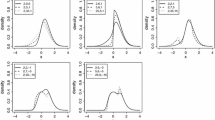Abstract
Folded normal distribution arises when we try to find out the distribution of absolute values of a function of a normal variable. The properties and uses of univariate and bivariate folded normal distribution have been studied by various researchers. We study here the properties of multivariate folded normal distribution and indicate some areas of applications.
Similar content being viewed by others
References
Chakraborty, A.K. and Chatterjee, M. (2010). On Multivariate Folded Normal Distribution. Technical Report No. SQCOR - 2010-02, SQC & OR Unit. Indian Statistical Institute, Kolkata.
Chatterjee, M. and Chakraborty, A.K. (2013). Some Properties Of C G (u,v). In Proceedings of International Conference On Quality and Reliability Engineering, Bangalore, India. To be published.
Elandt, R.C. (1961). The folded normal distribution: two methods of estimating parameters from moments. Technometrics, 3, 551–562.
Johnson, N.L. (1963). Cumulative sum control charts for the folded normal distribution. Technometrics, 5, 451–458.
King, J.R. (1988). When is a normal variable not a normal variable? Qual. Eng., 1, 173–178.
Kirmani, S. and Polansky, A.M. (2009). Multivariate process capability via lowner ordering. Linear Algebra Appl., 430, 2681–2689.
Leone, F.C., Nelson, L.S. and Nottingham, R.B. (1961). The folded normal distribution, Technometrics, 3, 543–550.
Liao, M.Y. (2010). Economic tolerance design for folded normal data. Int. J. Prod. Res., 18, 4123–4137.
Lin, H.C. (2004). The measurement of a process capability for folded normal process data. Int. J. Adv. Manuf. Technol., 24, 223–228.
Lin, P.C. (2005). Application of the generalized folded-normal distribution to the process capability measures, Int. J. Adv. Manuf. Technol., 26, 825–830.
Polansky, A.M. (2001). A smooth nonparametric approach to multivariate process capability, Technometrics, 43, 199–211.
Psarakis, S. and Panaretos, J. (2001). On some bivariate extensions of the folded normal and the folded T distributions. J. Appl. Statist. Sci., 10, 119–136.
Tallis, G.M. (1961). The moment generating function of the truncated multi-normal distribution. J. R. Stat. Soc. Ser. B Stat. Methodol., 23, 223–229.
Taam, W., Subbaiah, P. and Liddy, J.W. (1993). A note on multivariate capability indices. J. Appl. Stat., 20, 339–351.
Tong, Y.L. (1990). The multivariate normal distribution. Springer-Verlag, New York.
Vannman, K. (1995). A unified approach to capability indices. Statist. Sinica, 5, 805–820.
Wang, F.K. and Chen, J.C. (1998). Capability index using principal components analysis. Qual. Eng., 11, 21–27.
Author information
Authors and Affiliations
Corresponding author
Rights and permissions
About this article
Cite this article
Chakraborty, A.K., Chatterjee, M. On multivariate folded normal distribution. Sankhya B 75, 1–15 (2013). https://doi.org/10.1007/s13571-013-0064-5
Received:
Revised:
Published:
Issue Date:
DOI: https://doi.org/10.1007/s13571-013-0064-5
Keywords and phrases
- Folded normal distribution
- multivariate distributions
- multivariate folded normal distributions
- process capability indices



